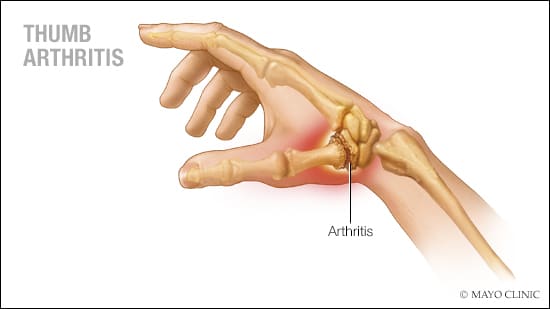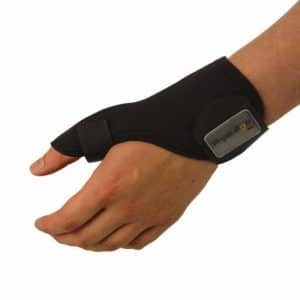Thumb arthritis refers to inflammation of the joints of the thumb. There are a number of distinct joints in the thumb, all of which can be affected by thumb arthritis. The inflammation may be due to “wear-and-tear” or osteoarthritis, a thumb injury, or rheumatoid arthritis.
Thumb arthritis can lead to severe pain, swelling, decreased strength and difficulty in performing simple tasks such as turning doorknobs, opening jars, or even snapping fingers. Common treatment methods for thumb arthritis include hand exercises, medications and splints. These methods don’t stop disease progression and ultimately thumb surgery may be necessary. It’s better to start treatment early so as to reduce the eventual thumb surgery cost.

Symptoms of Thumb Arthritis
Pain around the thumb and its surrounding joints is the most common symptom of thumb arthritis. Other signs and symptoms might include:
- Swelling, stiffness and tenderness at the base of your thumb
- Decreased strength when pinching or grasping objects
- Decreased range of motion
- Enlarged or bony appearance of the joint at the base of your thumb
Related: History of Surgery
Treatment of Thumb Arthritis
In the early stage of the disease, thumb surgery is not usually necessary, however as the condition progresses, surgical intervention may be necessary. There are various treatment options available for thumb arthritis and your doctor will recommend the best one for you based on your peculiar symptoms and modalities. Some of the treatment options include:
1. Medication
To relieve pain, your doctor might recommend:
- Topical medications, such as capsaicin or diclofenac, which are applied to the skin over the joint
- Over-the-counter pain relievers, such as acetaminophen (Tylenol, others), ibuprofen (Advil, Motrin IB, others) or naproxen sodium (Aleve)
- Prescription pain relievers, such as celecoxib (Celebrex) or tramadol (Conzip, Ultram)
2. Splint

thumb splint
Your doctor or physical therapist may recommend a splint for your thumb, especially at night. A thumb splint may look like a half glove with reinforcing material inside. Wearing this splint can help decrease pain, encourage the correct position for your thumb, and rest the joint.
This type of splint is sometimes called a “long opponens” or “thumb spica” splint. Splinting is often done continuously for three to four weeks. Then, the splint is worn some of the time, either at night or during certain daily activities that may strain the joint.
3. Thumb Exercise
The importance of exercise in our daily lives cannot be overemphasized. It helps to prevent a lot of medical conditions and can also be useful in the treatment of a lot more. In case of thumb arthritis, performing exercise that rejuvenates the thumbs and its associated structures can help to reduce pain and keep the thumb in shape. Simple exercises can include a thumb stretch, in which you attempt to touch the tip of your thumb to just under your pinky finger.
Another stretch, called IP, uses flexion. It requires you to hold your thumb stable with your other hand and attempt to bend just the upper part of the thumb. And an additional exercise is to simply touch the tips of each of your fingers to the tip of your thumb.
You should only do these exercises after consulting with your doctor or physical therapist. And be sure to get instructions to make sure you’re doing the movements correctly.
4. Thumb Surgery
When all else fails, thumb surgery may be last resort to in the treatment of thumb arthritis. There are a number of surgical options for treating thumb arthritis depending on the stage of the disease and severity of symptoms. After surgery, physical therapy will usually be recommended to aid in the recovery of function.
- Total Joint Replacement – This is also known as arthroplasty. Like hip or knee replacement surgery, this procedure involves the removal of all or part of the damaged thumb joint and replacing with an artificial implant.
- Fusion (Arthrodesis) – Arthrodesis eliminates pain by fusing the bones in the joint together. Surgeons create a socket by hollowing out the thumb’s metacarpal bone and then shaping the trapezium into a cone that fits inside the socket. A metal pin holds bones together to maintain proper alignment and prevent movement while the bones fuse.
- Ligament Reconstruction – This procedure stabilizes the (carpometacarpal joint) CMC joint by removing a portion of the damaged ligament and replacing it with a piece of the patient’s wrist flexor tendon. The transposed tendon reconnects and restores mechanical function of the thumb with the rest of the hand.
Thumb Surgery Cost
The thumb surgery cost depends on a lot of factors such as the anesthetic fee, private hospital fee, private operating facility fee, type of thumb surgery and insurance coverage.
Since each patient’s insurance coverage is different, it’s important to understand your plan in order to know how much, if any, of the surgery will be covered. For example, some patients may have high deductibles where insurance will cover only a small portion of the associated costs. On the other hand, some patients may have 80/20 plans where the insurance may cover a significant amount and the patient is only responsible for their copay.
The average cost of thumb surgery is around $5,000 – $10,000.
Read More: Lipoma Removal Cost


